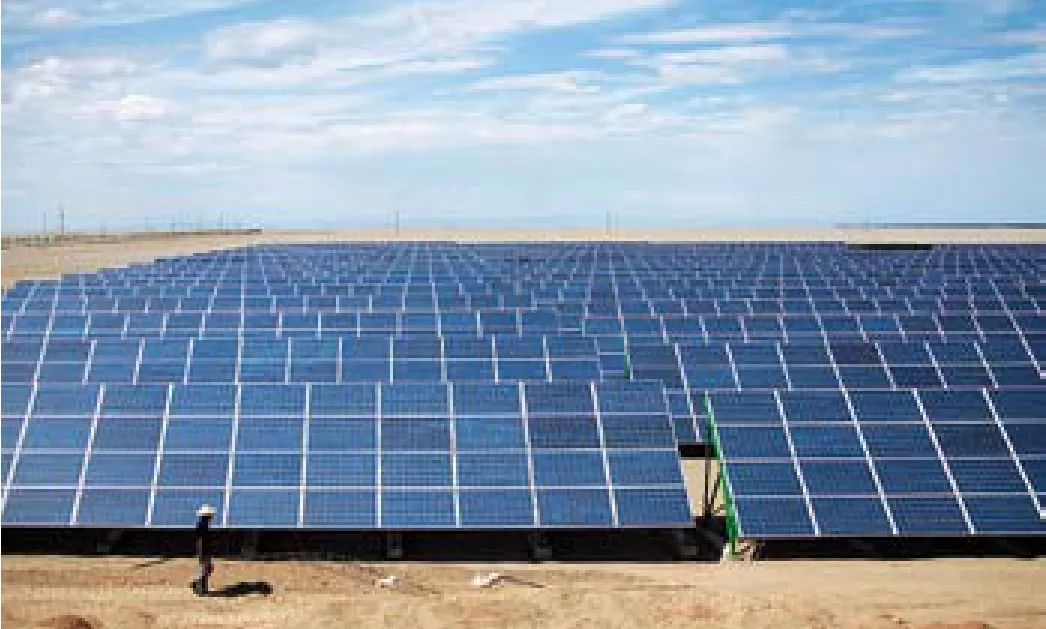New Energy Investment Fever
By WANG JUN
New Energy Investment Fever
By WANG JUN
Jiuquan, Gansu Province, ambitiously hoping to establish itself as a new energy base in northwest China, has attracted many investors
In Yumen, Jiuquan in Gansu Province,within the boundless Gobi desert, a two-story modern-style building stands like an oasis. Very different from the wild scenery outside, the picture inside the building is cheerful: The temperature is comfortable, the air is not as dry as that outside,green plants can be seen everywhere, and solar cells on the roof supply most of the electricity it needs.
This is the master control building of CECIC-HKC Wind Power Co. Ltd., a 60-40 joint venture of the China Energy Conservation and Environment Protection Group and Hong Kong Construction Holding Ltd. Starting operation in November 2009, the company, with 1.73 billion yuan ($255.15 million) in total investment, is one of the new energy businesses set up in Jiuquan during the past two years.Many others have followed suit this year.
Limited by harsh natural conditions and poor resources, the economic development of Gansu is slower than the national average.In Jiuquan, locals describe the place as one where “stones, beaten by strong wind, run around and not a blade of grass grows.” Now,however, Jiuquan has found a new way to develop its economy, by utilizing the “harsh”natural conditions.
Wind power
With Qilian Mountains standing in the south and the Gobi desert lying in the north,Jiuquan features a dry and windy climate.Within the city, Guazhou is called the “wind warehouse of the world” and Yumen the“draught of the world.”
According to figures from the Jiuquan Municipal Government, the city’s theoretical wind power reserves total 150 gigawatts(GW), of which 45 gw can be exploited in the short term. This supply accounts for oneseventh of the country’s total exploitable wind power, and the annual power generation time at full capacity is 2,300 hours.
Moreover, since 40 percent of the land area in Jiuquan is inhospitable Gobi desert,the city doesn’t need to requisition cultivated land or relocate residents in order to develop wind power.
Jiuquan started its wind power experiment early in 1996, when four 300-kw wind power turbines were erected at the Yumen Jieyuan Wind Power Plant. The city is among the fi rst in the country to develop wind power,just after Xinjiang and Inner Mongolia autonomous regions.
In April 2008, the National Development and Reform Commission (NDRC) approved the construction of a wind power base in Jiuquan with a total installed capacity of 12.71 gw.
According to figures by the Information Of fi ce of the Jiuquan Municipal Government,by the end of 2009, Jiuquan had installed 2.2 gw of wind power generation sets, and in 2010, the city plans to add another 3.16 gw.According to the NDRC’s plan, Jiuquan’s wind power installed capacity will hit 12.71 gw by 2015.
The“quick”in(3)a means nimble,which in a way shows a gift in music.But in(3)b refers to one’s fast speed.
Of the theoretical 150 gw and 45 gw of exploitable wind power in Jiuquan, the county-level city of Yumen has 30 gw of theoretical reserves and 20 gw of exploitable wind power, making it a major focus for new energy construction in the locality.
By 2007, Yumen had become the biggest wind power base in Gansu and by the end of 2009, the city’s wind power installed capacity had reached 1 gw, said Zhan Shunzhou,Secretary of the Yumen Committee of the Communist Party of China. By the end of 2010, that capacity will surpass 2 gw.
Equipment manufacturing
Since transportation expenses account for a large portion of the total equipment investment by wind power plants, using locally manufactured wind power equipment will greatly reduce transportation costs. Before 2008, the equipment used in Jiuquan came from the city of Lianyungang in Jiangsu Province. In 2008,however, the Wind Electricity Equipment Manufacture Industrial Park of Gansu Jiuquan Industrial Park was established.
The park, covering an area of 60,000 square meters, is now home to Gansu Goldwind Wind Power Equipment Manufacturing Co. Ltd., Sinomatech Wind Power Blade Co. Ltd. and many other manufacturers of wind power equipment such as wind power turbines and blades to be installed at the Jiuquan wind power base, 150 km away.
“Transporting a single wind power blade from Lianyungang to Jiuquan will cost 100,000 yuan ($14,749), but now the cost is only 20,000 yuan ($2,949) because it is produced here,” Yu Chengzhai, an official with the government of the Suzhou District of Jiuquan, toldBeijing Review.
According to the Information Office of the Jiuquan Municipal Government, the wind power equipment manufactured at the park will also be sold to wind power bases in Hami of Xinjiang Uygur Autonomous Region,western Inner Mongolia Autonomous Region and western Qinghai Province—all with a distance not exceeding 600 km from the park.
Solar power
Dunhuang, a county-level city in Jiuquan famous for its Mogao Grottoes, holds abundant solar energy resources. According to official figures, the annual duration of sunshine here reaches 3,246.7 hours and the city’s annual total radiation volume is 6,882.57 megajoules per square meter, making the city one of the areas nationwide with the richest solar energy resources.
Moreover, Dunhuang also has an expansive area of Gobi desert that can be used for solar energy generation. According to the Information Office of the Dunhuang Municipal Government, about 5,000 square km of Gobi desert in the city can be used for solar energy development, with a potential installed capacity of 1.36 trillion kw and a projected annual electricity output of more than 200 billion kwh.
The State Development and Investment Corp. (SDIC) and China Guangdong New Energy Development Co. (CGNEDC) have teamed up to construct two 10-megawatt solar photovoltaic power generation plants under a pilot project to harness Dunhuang’s ample solar power resources. The two plants were put into operation on July 30 this year.
According to figures from the Information Office of Dunhuang, the solar power plant of CGNEDC, whose construction began in September 2009, has already generated 1.07 gwh of electricity. The SDIC project, which started construction in October 2009, has generated 1.48 gwh of electricity.
Ren Tao, General Manager of SDIC Dunhuang Solar Power Co., said that the actual power generation in the first quarter of 2010 was better than what had been predicted.
General managers of the two companies say both of the plants are using photovoltaic panels produced by Yingli Group, a leading photovoltaic equipment manufacturer in China and in the world and a sponsor of the 2010 FIFA World Cup in South Africa.
Transmitting out
To meet the demand of constructing a new energy base in Jiuquan, the NDRC approved the planning made by the State Grid Corp. of China (SGCC) on the supporting grids of the Jiuquan wind power base. According to the plan, the main grid, hitting 750 kilovolts, will connect with the northwest grid via Lanzhou and Xi’an, and the supporting grid, being 300 kv, will connect with various counties, cities and wind power plants in Jiuquan.

SUN BENEFITS:A 10-megawatt solar power project in Dunhuang,Jiuquan, built by the State Development and Investment Corp. is in operation. With abundant solar energy resources,Dunhuang is expending a great deal of effort to develop its solar energy industry
The fi rst phase of the 750-kv ultra-highvoltage transmission and transfer project,to be completed and put into operation in September 2010, should be able to transmit 5 gw of electricity, according to the Information Of fi ce of the Jiuquan Municipal Government. In the meantime, SGCC is planning to build, by 2015, another 750-kv ultra-high-voltage line and a ±800 kv spot-tospot direct current transmission line that can transmit electricity to east China.
Some challenges
Wang Ningbo, Director of the Wind Power Technology Center of Gansu Electric Power Corp., thinks that new energy development in Jiuquan faces some challenges, fi rst of which is the transmission of electricity.
By the end of 2010, the total wind power installed capacity in Jiuquan will reach 5.36 gw, while the 750-kv ultra-high-voltage transmission and transfer line can only transmit 5 gw. This does not take into account the 2 megawatts of solar power generated in Dunhuang and other electricity generated by the city’s hydro and thermal power plants.
Jiuquan is planning to increase its total installed capacity to 12.71 gw by 2015 and 20 gw by 2020. Wang thinks that due to various uncertain factors, even with the world’s most advanced ±800 kv spot-to-spot direct current transmission line, further research must be done on whether all the electricity generated by 2015 and beyond can be effectively transmitted. It is also likely that the wind power base in Jiuquan will still face a transmission bottleneck.
Another challenge is the market. The combined installed capacity of wind power in Jiuquan will reach 5.36 gw this year. But the expected maximum load of electricity consumption in the whole Gansu Province this year is only 9.8 gw, Wang noted. In his opinion, it is almost impossible for the province, with a maximum electricity consumption of 9.8 gw, to digest the 5.36 gw of wind power alone.
Wang thinks that even if the whole province’s electricity consumption increases by an average annual rate of 10 percent, it is still unlikely for the Gansu grid, or even the country’s northwest grid, to digest the electricity generated by the wind power base in Jiuquan. Therefore, the consumption of the wind power generated by Jiuquan after 2015 must rely on the market of the whole country.
But a fact that should not be ignored is that many other provinces and autonomous regions of the country are developing their own new energy industries. For example,Gansu’s neighbors—Xinjiang, Inner Mongolia and Qinghai—are all developing wind power. Guangdong, Zhejiang, Jiangsu,Liaoning and some other provinces are developing nuclear power.
Hence, in the future Jiuquan may face a market bottleneck when establishing a new energy base, Wang concluded.

